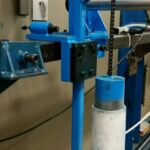The DoorSaver II looks like an interesting idea, but I wonder whether there are issues with replacing the original hinge pin. It wouldn’t be acceptable on a fire door unless allowed by the hinge manufacturer’s listings. And I’m also wondering about stress on the hinge and the hinge reinforcement. I’d much prefer an overhead stop but I’ve seen distributors enlarging the hole in a residential hinge pin stop in order to use it on a commercial hinge, so there is definitely a market for commercial hinge pin stops.
What do you think?
Thank you to Brendan Daley of Securadyne for sending me a photo of this product for Fixed-it Friday!
Here’s another video sent to me by John Lozano of Allegion:
You need to login or register to bookmark/favorite this content.





It’s a shame when a project runs over budget and there’s no money left to paint door edges. Apparently the funds for dumpsters took a hit also from the looks of the garage.
If it remains intact after a million cycles on a middle school gym door I’ll buy them by the truckload.
I don’t think that’s the intended application but it wouldn’t surprise me to see them there. How about a door within an assisted living dwelling unit?
A horrible idea! These hinge mounted stops destroy doors. It’s just like when maintenance people stick a broom handle into the hinge jamb on doors with closers to prop it open. It’s the best spot to stick anything if you really want to rip the door off the hinges or damage the jamb or hinge plates. I have never been a fan. But good luck I’m sure plenty of people will buy them.
They’re not buying them from me!
I agree with Daniel Davis – these are horrible and destroy doors, hinges, and frames
I was very curious myself about the strain and pressures it might apply to both the door and the frame.
I agree 100% agree with Daniel on this, they will destroy the hinge mounting plates.
I read your comment on preferring overhead stops, while I agree overhead stops may be a bit better than this idea no way do I consider overhead stops to be acceptable to use on a commercial door. We have long since banned them in our design specifications. If a floor or wall stop is not possible I would rather just use backcheck to control the door. Overhead stops put intense pressure on the upper hinge and frame ensuring failure in any door they are installed on, just a horrible product.
Really?! You use no stops on exterior doors if a floor or wall stop can’t be used? Interesting. How about an overhead stop in combination with a continuous hinge?
No getting around the laws of physics. These devices create a first class lever, serving to rip the hinge leafs out of their mortises. Very limited practicality — maybe a narrow HCWD dr to a closet not accessed by rowdy kids?
I would love to take you on a tour of one of our buildings that has overhead stops on it, the frames and doors on the exterior are mangled beyond repair. If a floor or wall stop works then we use it, if not then properly adjusted backcheck will work just fine.
Exactly Tom, its simple physics that force has to go somewhere.
One of my projects in downtown Boston had some exterior aluminum doors with no stops (the hardware came with the doors), and the wind whipped open the door, injured the person opening it, and damaged the curtainwall, door pull, closer, and door. One of the cardinal rules of hardware is that every door needs a stop, so I’m just surprised that backcheck has worked so well for you. Call me when the snow melts. 🙂
Lori, I agree with the others who say this is a bad idea. I’m a design engineer and can tell you the forces at that hinge pin are tremendous when the door is swung open rapidly. You can see how the whole structure flexes in the demo video. In fact, I would guess one active little kid running inside from playing in the yard could destroy the hinge, put a large dent or hole in the wall where the lever or knob lands, and maybe even rip the hinge screws out of the door jamb. Not a good solution.
I think all new product ideas should be run past this crowd. 🙂
This *might* be okay on a 24″ wide interior luan door, but you know some idiot is going to put them on heavier doors.
Bad, period!
Seems like Archimedes’ work on levers has been forgotten. Pity the demo wasn’t on a full-sized door, wind or child-assisted….
Lori you must be psychic!
I just sat down here to research stops for a set of middle doors in a bank of doors where floor stops are a no go.
The “authorities” said use a hinge pin stop, but I agree they only make money for the door companies doing hinge pocket repairs.
Neat product but I agree with others that it wont last long in the roughest environment on the planet… Middle school cafeteria doors….
I would use a GJ 90 overhead stop or a spring-Cush closer, but at least one commenter will disagree. 🙂
I already have the GJ904H template ready to go!!
Just have to work around the existing pesky cheapo closer with a drop plate and we’re ready for the acid test….
I went back a re-watched the DoorSaver_II video. The presenter demonstrates the product on a residential door and at 45 seconds into the video he even states the product is intended for a residential hinge. The stop replaces the middle hinge pin (not the top). When he demonstrates product capability, he pushes the door open softly using his index finger. This product may produce acceptable results on a hollow core interior door, but no way is it for use on a commercial door.
As for Keith never using an overhead stop, I too am surprised. Door detailers are taught every door needs a stop. BC is good, but in a PA mount it may come on too late to decelerate and stop the door (unless there is a BC position valve on the closer). I’m not criticizing Keith…I’m just surprised you rely purely on BC.
As for the GJ stop, it’s okay…better than nothing. 🙂
Hi David –
There is a commercial version of the Doorsaver II: http://doorsaver.com/products/doorsaver-ii-commercial/, but the same video appears on both pages so I think they are similar.
I will let the GJ comment slide, this time. 🙂
– Lori
Shawn Mahoney would have a comment or two about the use of overhead stops. I’ve never met anyone so passionate towards their use than Shawn. It’s a tough argument, if you’re on the opposite side.
Who is stopping you from using a O/H stop and combining it with a little back check to split the load.
Good point!
this product wouldn’t fly here (in Korea) due to generally bad reinforcement – the leaf would get pulled out from the frame in no time – WATCH OUT!
Using just backcheck is working perfectly, earlier in my career I to was an advocate of overhead stops but I spend everyday in the middle of an opening testing ground and the facts prove the theory wrong. These doors speak for me, I don’t need to argue about it.
“Splitting” the load has a number of issues and there is no need for it.
Just a month ago we had a hollow metal door that is less than 6 months old, the contractor put an overhead stop on it (defying design standards! oh the humanity) we were called to the opening and sure enough the upper hinge mount in the frame was destroyed.
Our doors need to last 25years here, installing overhead stops ensures failure something we cannot afford.
Thanks for sharing your insight, Keith!
Lori,
I have tried this in one of the project that I handled. But the issue as you mention, the warranty for the hinge will be void as per the manufactures. is there any codes or anything related to the use of this product.
Regard’s
Maharoof
It’s not something that’s specifically addressed by the codes and standards. It would be up to the manufacturer.
In our schools not only are exterior floor stops a tripping hazard/liability issue but they are destroyed by vandals in short order. The round rubber type get lit on fire, brass ones get broken off. Overhead stops get ripped out of the doors and closer arm stops bend the arms, even cush stops take a terrible beating but we are using more of them with increased backcheck. That seems to be a good combination. On some exterior doors that don’t open to a wall we have resorted to installing bollards as stops. Bright Yellow Bollards!
When I did residential work I made good use of the little Ives 404 door stops mounted on the door, usually bumping into a tub or toilet. Hinge stops were a last resort.